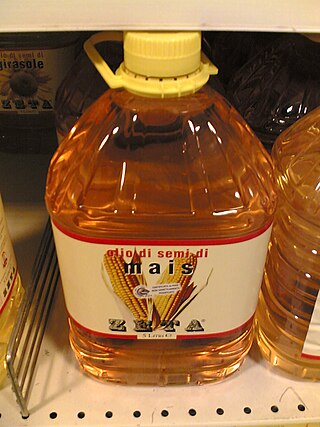Top Qs
Timeline
Chat
Perspective
Corn oil
Oil from the seeds of corn From Wikipedia, the free encyclopedia
Remove ads
Corn oil (North American) or maize oil (British) is oil extracted from the germ of corn (maize). Its main use is in cooking, where its high smoke point makes refined corn oil a valuable frying oil. It is also a key ingredient in some margarines. Corn oil is generally less expensive than most other types of vegetable oils.

Corn oil is also a feedstock used for biodiesel. Other industrial uses for corn oil include soap, salve, paint, erasers, rustproofing for metal surfaces, inks, textiles, nitroglycerin, and insecticides. It is sometimes used as a carrier for drug molecules in pharmaceutical preparations. Due to its low cost, corn oil is also one of the most popular choices for use in egg addling, an avian population control method in which a bird's egg is coated with oil to prevent the embryo from receiving oxygen.[1][2]
Remove ads
Production
Almost all corn oil is expeller-pressed, then solvent-extracted using hexane or 2-methylpentane (isohexane).[3] The solvent is evaporated from the corn oil, recovered, and re-used. After extraction, the corn oil is then refined by degumming and/or alkali treatment, both of which remove phosphatides. Alkali treatment also neutralizes free fatty acids and removes color (bleaching). Final steps in refining include winterization (the removal of waxes), and deodorization by steam distillation of the oil at 232–260 °C (450–500 °F) under a high vacuum.[3]
Remove ads
Constituents and comparison
- Of the saturated fatty acids, 80% are palmitic acid (lipid number of C16:0), 14% stearic acid (C18:0), and 3% arachidic acid (C20:0).
- Over 99% of the monounsaturated fatty acids are oleic acid (C18:1 cis-9)
- 98% of the polyunsaturated fatty acids are the omega-6 linoleic acid (C18:2 n-6).[33][34]
Remove ads
See also
References
Further reading
External links
Wikiwand - on
Seamless Wikipedia browsing. On steroids.
Remove ads

